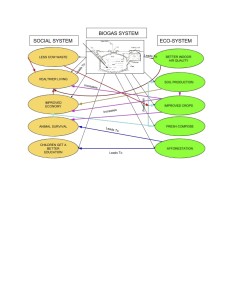The biogas video shows the coupling of the human-environmental system and the interactions between humans and the environment. To display the interaction in my system diagram, I listed the components of the social system and the eco-system that have a direct interface with one another than dug a little deeper to identify the non-direct collaboration. To start, by installing a biogas system removes cow dung from the community. This will improve the overall health of the people living in the town; plus removing the dung creates compost, which leads to improved soil conditions resulting in increase agriculture. Another aspect of utilizing the biogas system is better indoor air quality inside the house. This is achieved by removing wood burning stoves and installing gas-burning stoves. A byproduct of this improvement is increased health. The biogas system has increased the local economy too; the women of the town are able to bag soil that is produced by composting. Additionally, local bricklayers are able to earn a living by building the top of the biogas container. Lastly, the children of the town are able to get a better education. The mornings usually consisted of gathering branches and wood; now they are able to attend school. One more interaction between the social system and ecosystem is reforestation and increase wildlife survival rate, which is achieved by not removing excess forestry to burn for cooking.
Reference:
“Coupled Human-Environment Systems.” Geographic Perspectives on Sustainability and Human-Environment Systems. Pennsylvania State University, 2016. Web. 26 Jan. 2016. <https://www.e-education.psu.edu/geog030/node/324>.


Hello! My name is Sara Getson and I am a plant science major at University park. Here is a link to my blog http://geog030.dutton.psu.edu/2016/01/27/biogas-in-india-2/ .
Your post caught my eye mainly because of the color coding, as well as the diagram of the actual biogas system. I thought that was really cool. Color coding the different subsystems affected is a really good idea. It makes it easier for the reader to understand what is going on in the diagram. Your explanation was also very concise and planned which went with the diagram nicely. The intertwining, color coded arrows were really good and helped me not to get lost as to where they were going or coming from. Overall though I really liked the way that you chose to represent this system with your diagram!